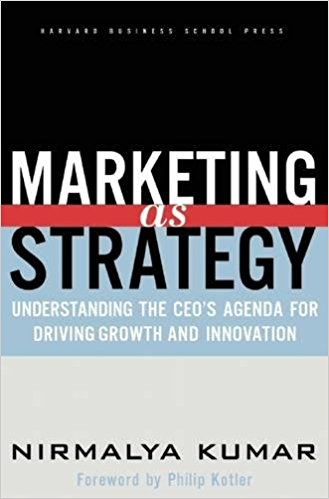Marketing as Strategy Summary
5 min read ⌚
 Understanding the CEO’s Agenda for Driving Growth and Innovation
Understanding the CEO’s Agenda for Driving Growth and Innovation
Everything you know about marketing – is no longer everything.
Nowadays, marketing is much more than it used to be, and marketers need to become strategists rather than mere tacticians.
In the summary below we are acquainting you with everything a marketer needs to become in order to succeed, and we are giving you the steps toward starting to drive the market instead of letting it drive you.
Who Should Read “Marketing as Strategy”? And Why?
The specialized departments in each company have helped them enormously in their quest of becoming more profitable and thriving in the highly competitive market.
However, marketing stays behind – at least that is why the author of “Marketing as Strategy,” Nirmalya Kumar argues. He contends that marketing does not evolve along with the market, and the focus on the basic tactics makes it no longer as useful as it once was.
In “Marketing as Strategy” he addresses this problem and tries to find a solution to it by offering seven steps which can help marketers become the leaders of tomorrow.
We recommend this book to all marketers who want to evolve and push their companies to evolve along with them.
About Nirmalya Kumar
 Nirmalya Kumar is a director of the Centre for Marketing and co-director of the Aditya V Birla India Centre at the London Business School and a professor of marketing.
Nirmalya Kumar is a director of the Centre for Marketing and co-director of the Aditya V Birla India Centre at the London Business School and a professor of marketing.
“Marketing as Strategy Summary”
As time goes by, many executives and business owners are having doubts about the value of their marketing departments.
Yes, they do think marketing is of some importance, but they are not sure whether it can actually produce results which will take their companies a step closer to achieving the planned strategic goals.
This trend is not new.
Marketing has been in a crisis for the last 20 years. The globalization brought tougher competition, the number of products has increased and so have the customer expectations, and markets have fragmented.
The traditional 4Ps marketers care so much about price, promotion, position, and placement, no longer have the same worth as in the past.
Marketing is no longer about just selling products and linking up with new distribution partners. Marketing has become a form of strategic, future-oriented thinking, and marketers need to develop their brand image, increase efficiency, increase the levels of customer satisfaction by improving customer service, and continually discover new opportunities.
Below we will list the seven steps that can take you from being a marketing tactician to marketing strategist.
-
- “From market segments to strategic segments”: instead of targeting groups of customers to convey specific messages, target them with activities that create value for them.
-
- “From selling products to providing solutions”: forget about differentiation, the competition is too intense. Instead of wasting time and effort on such an impossible mission, attract and keep your customers by giving them solutions and fulfilling their needs. The road to becoming a solution provider is not simple, and it requires for culture change, transformational leadership, cost-cutting, and a focus on customers.
-
- “From declining to growing distribution channels”: open your mind to new distribution methods.
-
- “From branded bulldozers to global distribution partners”: learn how you can cooperate with gigantic retailers.
-
- “From brand acquisitions to brand rationalization”: get rid of the weakest brands, and put your time and effort into creating value around the strongest ones.
-
- “From market-driven to market-driving”: you do not have to develop new products to be innovative. You just need to create new concepts that “change an industry’s rules and boundaries.” Said simply, you need to give new benefits at a lower price.
- “From strategic business unit (SBU) marketing to corporate marketing”: stop the short-term thinking and keep your marketing efforts in check with the “goals and overall strategy of the firm.”
It is time you think of your customers as the foundation of your business. Stop thinking about profits, since, if you lose your customers, you can forget all about the profits.
What this means is that you need to put effort into building long-term relationships with your customers, and creating loyalty.
So, you need to change the “4Ps” with the “3Vs” of strategic segmentation, which we cover in the key lessons below.
So, to recap: focus on your customers, since they are the basis of your business, try to innovate regarding the values you give your customers, as well as the distribution channels, stop selling just products and become a service provider, and change your corporate culture and start rewarding creativity.
Key Lessons from “Marketing as Strategy”
1. Common Characteristics of Market-Driving Companies
2. The “3Vs” of Strategic Segmentation
3. Common Characteristics of Weak Brands
Common Characteristics of Market-Driving Companies
-
- They rely on vision rather than market research.
-
- They attract customers from a variety of market segments.
-
- They create new, lower price points for quality and service, and educate their customers about the value of their offerings.
-
- They develop new channels and logistics.
- They grow through positive customer word-of-mouth.
The “3Vs” of Strategic Segmentation
-
- “Valued customer.”
-
- “Value proposition” – What do your valued customers want?
- “Value network” – What’s the best way to deliver the product?
Common Characteristics of Weak Brands
They:
-
- “Have small market share.”
-
- “Suffer from poor or negative profitability.”
-
- “Consume rather than contribute to cash flow.”
-
- “Lack support from important channel members.”
-
- “Exhaust disproportionate amounts of managerial resources.”
- “Add little strategic value to the firm.”
Like this summary? We’d Like to invite you to download our free 12 min app, for more amazing summaries and audiobooks.
“Marketing as Strategy” Quotes
If one believes that everyone in the organization should serve the customer and create customer value, then obviously everyone must do marketing regardless of function or department.
In a global marketplace, customers are awash in supplier choices, and differentiation based on products is usually unsustainable.
We must reaffirm the fundamental purpose of a corporation: to serve customers over time and not to maximize shareholder wealth.
At a solution-driven company, service is the ‘product’ that the customer is purchasing and the products are bundled in as needed.
The key to the success of market-driving firms is that they create and deliver a leap in benefits while reducing the sacrifices and compromises that customers make to receive those benefits.
Our Critical Review
“Marketing as Strategy” addresses the problem which relates to marketing (as it is usually practiced) being outdated. Nirmalya Kumar tries to solve this problem by motivating marketers to change the traditional “4Ps” with the “3Vs” which focus on value.
The steps that he offers are practical and useful, and anyone can follow them. We highly recommend it to all marketers who are not afraid of embracing new ideas and perspectives.
Emir is the Head of Marketing at 12min. In his spare time, he loves to meditate and play soccer.


 Understanding the CEO’s Agenda for Driving Growth and Innovation
Understanding the CEO’s Agenda for Driving Growth and Innovation 




